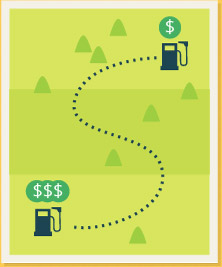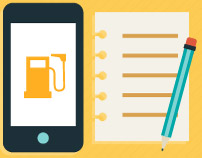How Gas Prices Work

You can count on the fact that gas prices are never static—gasoline prices at the pump are closely related to the price of crude oil. As you may already know, oil prices are often out of America’s control; oil prices that impact gas prices rise and fall based on supply, demand, and projected supply and demand for the future.
Why do drivers in the US care so much about gas?
If you want to get from point A to point B on your daily commute, gas prices can quickly add up. How much you spend on gasoline is directly related to the fuel economy of your vehicle. Fuel economy simply refers to a car’s fuel efficiency; this fuel efficiency is calculated based on the amount of fuel consumed during a set distance traveled. Fuel economy can be compared vehicle by vehicle to select an inexpensive, economical car for everyday use.
At the time this piece was made, gas prices in the US stood at $3.61 per gallon for regular gasoline, according to AAA’s Daily Fuel Gauge Report.
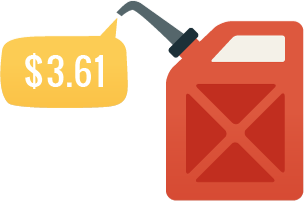
The EPA rates vehicle fuel economy “based on laboratory tests conducted by manufacturers
according to federal regulations.”
The US Department of Energy states that the average
fuel economy for a 2013 vehicle is…
for cars
for light-duty
cars and trucksfor trucks
Compared to fuel economy in 1975, passenger vehicles of today are nearly twice as efficient.
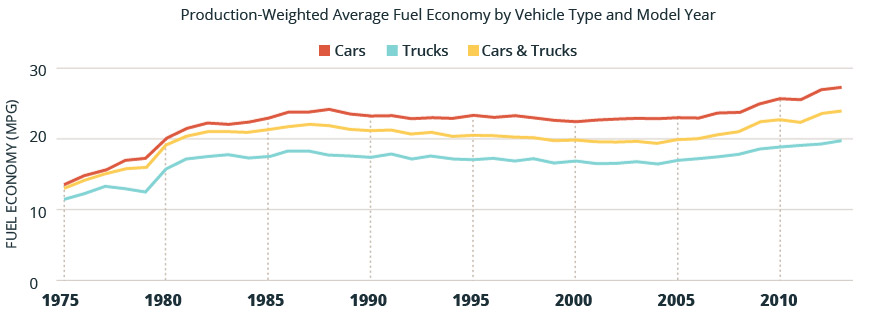
Based on an example from the US Department of Energy, it’s plain to see that your car’s fuel economy matters, especially in light of unpredictable gas prices at the pump.
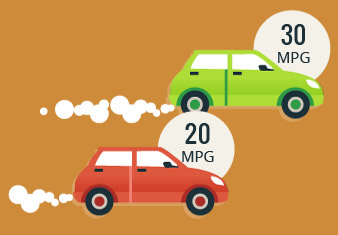
These figures are based on averages of driving 15,000 miles per year at $3.70 per gallon.

Over five years, a less efficient vehicle could cost you a whopping $4,625 extra in gas.
The cost to keep a car fueled and running certainly isn’t cheap.
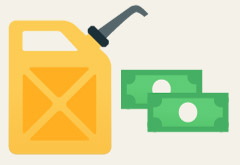
Of course, where you live makes a difference. Depending on where you are located in the country, you could pay noticeably more or less for gasoline.
The EIA estimates that July 7, 2008, held the record for the highest average retail gas prices in history.
Prices reached $4.11 per gallon, hitting a record high after adjustment for inflation using the Consumer Price Index.
Projected gas prices for the future fall slightly short of this mark. The EIA confirms average retail prices for regular gasoline at $3.48 per gallon in 2014, with projected prices at $3.38 per gallon in 2015.

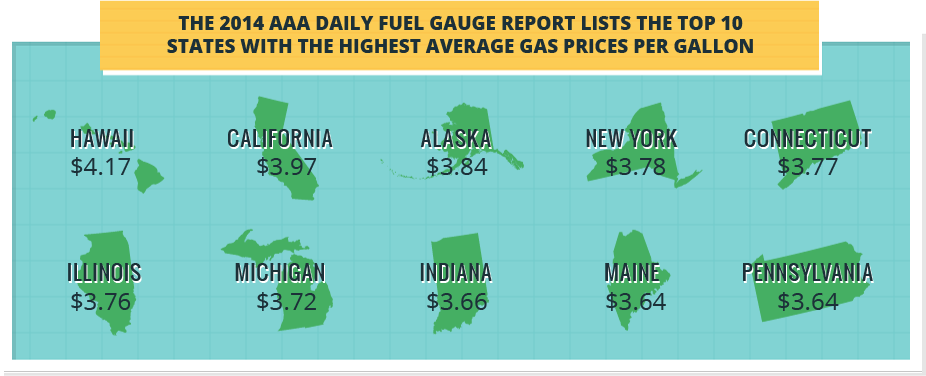

The United States uses 20 million barrels of oil products a day, according to the DOE. Half of this oil is consumed as vehicle fuel. As previously mentioned, gas prices can ebb and flow due to supply and demand; gas demand rises in the summer as vacation travel increases.
This doesn’t change the fact that gas is a consumer product. The price of gas is often directly linked to crude oil, but there are a number of other factors that determine the final price paid at the pump. The US Department of Energy confirms that for each dollar spent on gas, 67 cents pays for crude oil, 12 cents for refining, 12 cents for taxes, and 9 cents for distribution and marketing.
Let’s take a closer look at five primary factors that influence your gas prices:
What do we pay for in a gallon of Regular Grade Gasoline?
-
Crude Oil
Crude oil suppliers clearly take the biggest piece of the pie. Prices are set by the Organization of the Petroleum Exporting Countries; the amount of crude oil produced in oil-exporting nations sets the price per barrel of oil. Even when crude oil is plentiful, supply quality still matters. Oil is graded on its viscosity and impurities—what is called light/sweet crude oil is highly in demand as it contains fewer impurities and requires less processing time.
-
Refining Costs
Though refiners normally charge 20 cents per gallon processed, refining costs can vary greatly by state. Refining for summer blend gasoline that meets Clean Air Act standards is often pricier as clean air gas formulas are more difficult to make.
-
Taxes
Taxes on gas have increased dramatically. Taxes per gallon totaled at 1.5% in 1950, compared to state and local taxes per gallon of gasoline at 20% in 2011.
-
Distribution and Marketing
These expenses are charged to cover the cost of transport and shipment of gasoline from refineries to distribution points to gas stations. The transportation cost is passed directly to the customer, along with oil company brand marketing expenses.
-
Pump Markup
An allotment of the money that you pay for gasoline also covers service station overhead. While it’s easy to blame high gas prices on gas station markup, service stations normally only take a few cents a gallon. Markup laws in some states set limitations to protect mom-and-pop service stations from being driven out of business.
Gas prices can still be confusing Here are the top 10 gasoline FAQs from the US DOE and EIA

Where can I find information on average national and regional gas prices?
The Gasoline and Diesel Fuel Update from the Energy Information Administration is updated weekly; also, check California Gasoline & Gasoline Prices.

Why do gas prices vary from one state to the next?
Retail gas prices are often higher the farther they are sold from the supply source—such as, refineries, ports, pipelines, and blending terminals.

How can I learn more about gasoline taxes?
Federal and State Motor Fuel Taxes from the EIA is the recommended resource.
Where does my gasoline come from?
While the EIA cannot guarantee where gasoline at any given station comes from, a helpful crude oil and gasoline flowchart can be seen below:
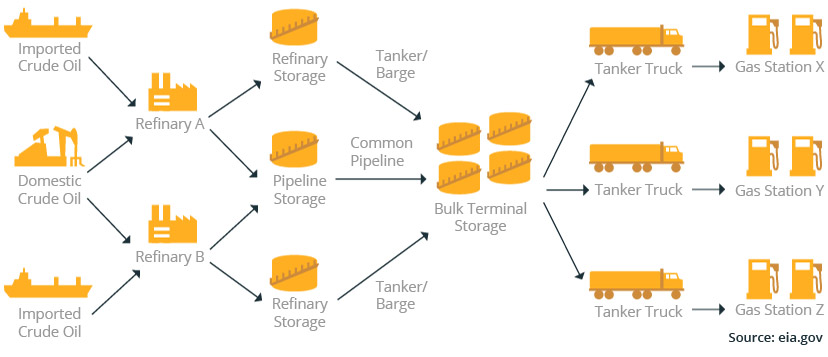
What is Reformulated Gasoline (RFG)?
Reformulated gasoline is blended to burn cleaner than conventional gasoline to reduce toxic, smog-forming pollutants emitted into the air.
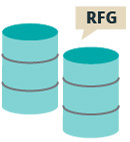
How many gallons of gasoline are produced by one barrel of oil?
US refineries can make roughly 19 gallons of gasoline per 42-gallon barrel of crude oil.


Where can I find RFG?
Reformulated gasoline is currently required in cities with high smog levels and is optional in other locations, as seen on the map below:
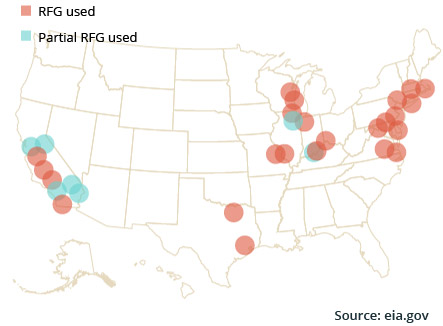
How much oil does Alaska produce?
As of 2013, Alaska was responsible for 7% of oil production in the US; most Alaskan crude oil is shipped to refineries in Alaska, Washington, Hawaii, and California.
How much petroleum does the United States import?
In 2012, the US imported 10.6 million barrels of petroleum a day from 80 different countries; 3.2 MMbd of crude oil and petroleum products were exported.

Do we have enough worldwide oil to meet future needs?
The EIA International Energy Outlook 2013 projects that the global crude oil supply will be adequate for at least 25 more years.
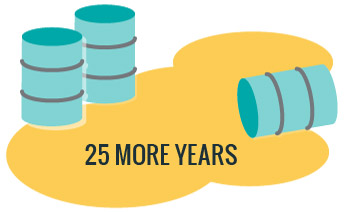
The gas market is ever-fluctuating, but in the present
moment, consumers can count on good news.
Summer gas prices in 2014 experienced an unexpected dip due to minimal conflict with international oil suppliers. Supply
is up to keep gas prices reasonable, after oil production resumed in Libya; oil production in the US remains strong.
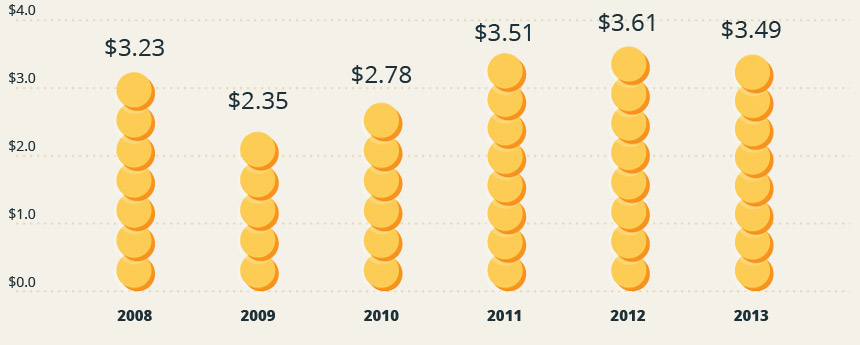
Gas prices are unpredictable, but it’s still possible to
protect your bank account over the long-term.
Here are 10 proven ways to cut down on fuel costs and save money:
-
Rethink your driving
If you drive like you’re in a video game—speeding, braking, and tailgating—it’s time to take your foot off the accelerator. Not only is aggressive driving dangerous, but it can cost you in excess gas expenses. A minor change, like using cruise control on the highway, could provide up to 14% better gas mileage, based on Land Rover fuel economy in an Edmunds.com test.
-
Don’t idle
Idling in your vehicle contributes to air pollution and is a drain on fuel and money. If you plan to wait for an extended period of time, longer than the length of a stoplight, turn off your car to save gas. In the same vein, air conditioning is another “extra” that can waste fuel; run your AC on the recirculating economy setting, except for very hot days.
-
Get regular tune-ups
Regular maintenance on your vehicle can improve fuel economy and increase gas mileage by up to 4%, according to the FTC. Likewise, it is important to pay attention to tire inflation whenever you hit the road; properly inflated and aligned tires can improve fuel economy by up to 3% and decrease the risk of accidents caused by blowouts.
The next time that you get your oil changed, ask for Energy Conserving motor oil (endorsed by the American Petroleum Institute) with friction-reducing additives to improve gas mileage.
-
Seek out the
cheapest gas stationIn most cases, you’ll be able to spot a better deal a mile away; grocery stores, wholesale clubs, and department stores with built-in gas stations are known for their rock-bottom prices. Steer clear of service station/mechanic shop combos, likely to have higher pump prices.
-
Drive the extra mile for cheap gas
In cities, you may find a better deal if you fill up in the suburbs. If you’re familiar with your town, try to fuel up in lower cost neighborhoods compared to more prosperous districts. Gas stations located next to valuable land automatically absorb higher land taxes.
-
Shop for
gas prices competitivelyIn the modern age of technology, it’s easier than ever to look for the cheapest gas prices in town. If you have a smartphone, download a gas price comparison app like GasBuddy. Or, take note of weekly gas price specials advertised at local stations and plan accordingly.
-
Fill up at the right time
If you fill up your gas tank weekly on your commute, try to hit the pumps on a Wednesday or Thursday before 10 AM. CEO of Dallas-based Breitling Oil and Gas Chris Faulker reveals that weekly prices automatically spike on Thursdays before weekend travel; gas station owners also set daily prices after 10 AM.
-
Carpool when you can
If fuel costs really are eating into your budget, it is time to think outside the box. Try to take the bus, light rail, or train, or ask a friend to carpool to work. Public transportation and carpooling are easy on the wallet and beneficial to the environment.
-
Trade in your car for a
more fuel efficient vehicleBy now, you know that fuel economy matters in how much you will spend at the pump over the long-term. Small, compact cars will get better gas mileage compared to “gas-guzzling” SUVs; though a hybrid or electric vehicle may cost more upfront, gas savings will pay off year after year.
-
Purchase with the right
credit cardLast but not least, the way that you pay for gas could make a big difference. Some major credit cards offer up to 5% cash back with gas purchases. Specialty gas stations, like wholesalers and grocery stores, may also offer membership rewards in the form of gas discounts. Kiplinger.com recommends PenFed Platinum Rewards Visa, TrueEarnings Card From Costco and American Express, and Amazon.com Rewards Visa from Chase as top gas-friendly rewards creditcards.
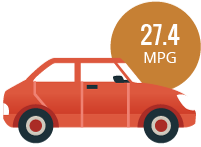

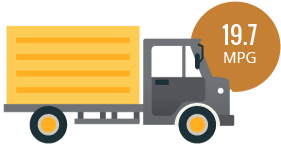
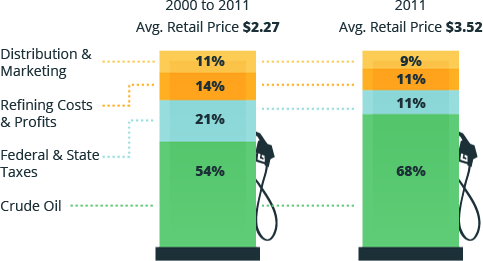




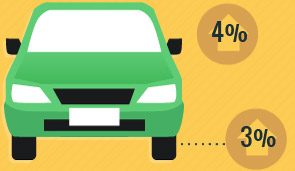
 The next time that you get your oil changed, ask for Energy Conserving motor oil (endorsed by the American Petroleum Institute) with friction-reducing additives to improve gas mileage.
The next time that you get your oil changed, ask for Energy Conserving motor oil (endorsed by the American Petroleum Institute) with friction-reducing additives to improve gas mileage.